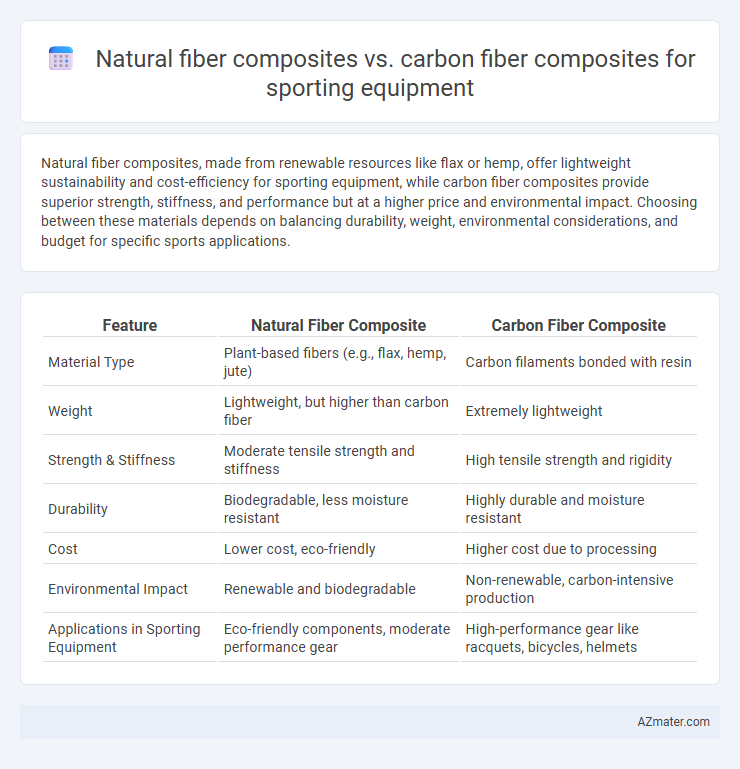Natural fiber composites, made from renewable resources like flax or hemp, offer lightweight sustainability and cost-efficiency for sporting equipment, while carbon fiber composites provide superior strength, stiffness, and performance but at a higher price and environmental impact. Choosing between these materials depends on balancing durability, weight, environmental considerations, and budget for specific sports applications.
Table of Comparison
| Feature | Natural Fiber Composite | Carbon Fiber Composite |
|---|---|---|
| Material Type | Plant-based fibers (e.g., flax, hemp, jute) | Carbon filaments bonded with resin |
| Weight | Lightweight, but higher than carbon fiber | Extremely lightweight |
| Strength & Stiffness | Moderate tensile strength and stiffness | High tensile strength and rigidity |
| Durability | Biodegradable, less moisture resistant | Highly durable and moisture resistant |
| Cost | Lower cost, eco-friendly | Higher cost due to processing |
| Environmental Impact | Renewable and biodegradable | Non-renewable, carbon-intensive production |
| Applications in Sporting Equipment | Eco-friendly components, moderate performance gear | High-performance gear like racquets, bicycles, helmets |
Introduction to Composite Materials in Sporting Equipment
Sporting equipment increasingly utilizes composite materials for enhanced performance and durability. Natural fiber composites, made from renewable fibers like flax or hemp combined with resins, offer lightweight, eco-friendly alternatives with good impact resistance. Carbon fiber composites, composed of carbon filaments embedded in a polymer matrix, deliver superior stiffness, strength-to-weight ratio, and vibration damping, making them ideal for high-performance sports gear.
Overview of Natural Fiber Composites
Natural fiber composites consist of renewable fibers such as flax, hemp, or jute embedded in polymer matrices, offering a lightweight and eco-friendly alternative for sporting equipment. These composites provide good impact resistance, vibration damping, and are biodegradable, making them suitable for sustainable sports gear like tennis rackets, skis, and bicycle components. Although they exhibit lower mechanical strength and stiffness compared to carbon fiber composites, natural fiber composites reduce environmental impact and manufacturing energy consumption.
Overview of Carbon Fiber Composites
Carbon fiber composites are highly valued in sporting equipment for their exceptional strength-to-weight ratio, stiffness, and durability, making them ideal for high-performance applications like tennis rackets, bicycle frames, and golf clubs. These composites consist of carbon fibers embedded in a polymer matrix, typically epoxy resin, which enhances load transfer and impact resistance. Their superior mechanical properties compared to natural fiber composites contribute to improved athlete performance and equipment longevity.
Mechanical Properties: Strength and Flexibility Comparison
Natural fiber composites in sporting equipment offer moderate tensile strength and high flexibility, making them suitable for applications requiring impact absorption and lightweight performance. Carbon fiber composites provide superior mechanical strength and stiffness with excellent fatigue resistance, enabling enhanced durability and responsiveness in high-performance sports gear. The balance between strength and flexibility in natural fibers often results in more eco-friendly options, while carbon fibers deliver unmatched structural integrity for competitive advantage.
Weight and Performance Efficiency
Natural fiber composites offer significantly lower weight compared to traditional materials, enhancing agility and reducing fatigue in sporting equipment. Carbon fiber composites provide superior performance efficiency through high stiffness-to-weight ratios and exceptional strength, allowing for greater precision and durability in high-impact sports. The choice depends on balancing weight savings with performance demands, where carbon fiber leads in efficiency but natural fibers appeal for sustainability and cost-effectiveness.
Environmental Impact and Sustainability
Natural fiber composites used in sporting equipment offer significant environmental advantages due to their biodegradability, renewable sourcing, and lower carbon footprint compared to carbon fiber composites, which rely on energy-intensive production and non-recyclable materials. The cultivation of natural fibers such as hemp, flax, and jute supports sustainable agriculture practices and reduces reliance on fossil fuels, contributing to a circular economy. Carbon fiber composites, while offering superior strength-to-weight ratios, pose challenges in disposal and recycling, making natural fiber composites a more sustainable choice for eco-conscious sports manufacturers.
Cost Analysis: Natural vs. Carbon Fiber
Natural fiber composites typically cost 30-50% less than carbon fiber composites due to lower raw material prices and reduced energy consumption during production. While carbon fiber composites offer superior strength-to-weight ratios, their manufacturing process involves expensive precursors and labor-intensive curing, driving up costs significantly. The affordability of natural fiber composites makes them an attractive choice for budget-sensitive sporting equipment without severely compromising performance.
Durability and Longevity in Sports Applications
Natural fiber composites offer moderate durability and biodegradability, making them a sustainable choice for low-impact sporting equipment, but they tend to have lower resistance to moisture and UV degradation compared to synthetic composites. Carbon fiber composites provide superior durability and longevity in sports applications, exhibiting high tensile strength, excellent fatigue resistance, and minimal weight, which results in longer-lasting performance in demanding conditions. The enhanced mechanical properties of carbon fiber composites translate into extended equipment lifespan and consistent performance under repetitive stress and extreme environments.
Popular Sporting Equipment Using Each Composite
Natural fiber composites are widely used in sporting equipment such as tennis rackets, cricket bats, and surfboards due to their lightweight, eco-friendly properties, and good impact resistance. Carbon fiber composites dominate high-performance gear like bicycles, golf clubs, and hockey sticks, offering superior strength-to-weight ratio and enhanced stiffness for professional athletes. The choice between natural fiber and carbon fiber composites depends on the balance between sustainability and performance required for specific sporting applications.
Future Trends and Innovations in Composite Materials
Natural fiber composites in sporting equipment are gaining traction due to their sustainability, biodegradability, and lightweight properties, appealing to eco-conscious athletes and manufacturers. Carbon fiber composites continue to dominate high-performance gear with superior strength-to-weight ratios and advanced stiffness, but innovations are leading to hybrid composites that blend natural and carbon fibers for optimized performance and environmental impact. Future trends emphasize bio-based resins, enhanced fiber treatments, and recycling technologies to improve durability, reduce carbon footprint, and increase application versatility in competitive sports.

Infographic: Natural fiber composite vs Carbon fiber composite for Sporting equipment
 azmater.com
azmater.com